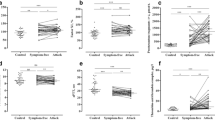Summary
In the present study, the plasma fibrinolytic activity in 30 cases of corticaloartery territory cerebral infarction (CACI) and 32 cases of perforating artery territory cerebral infarction (PACI) within 3 days after ictus, and 30 sex- and age-matched controls without cardio-cerebrovascular diseases were evaluated by a comprehensive panel of assay, including the plasma tPA activity, PAI activity, endothelial capacity of tPA release and PAI/tPA ratio. The results showed that the plasma fibrinolysis and the endothelial potential to release tPA responding to stimulation in bcoch subtypes of the patients were significantly lower than those in the controls, which provide the theoretical basis for carrying out the thrombolytic therapy in the ischemic stroke. And the study also suggested that increased plasma PAI activity could increase the risk of AS chrombotic events with increased serum triglyceride level.
Similar content being viewed by others
References
Levine S R, Brott T G, Thrombolytic therapy in cerebrovascular disorders. Progress in Cardiovascular Disorders, 1992; 19: 235
Greaves M, Coagulation abnormalities and cerebral infarction. J Nevrol Neurosurg Psychiat, 1993; 56: 433
Dawson S, Henney A, The status of PAI-1 as a risk factor for arterial and thrombotic disease: A review. Atherosclerosis, 1992; 95: 105
Dawson S, Hamsten A, Wiman Bet al. Genetic variation at the plasminogen activator inhibitor1 locus is associated with altered levels of plasma plasminogen activator inhibitor-1 activity. Arteriosclerosis and Thrombosis, 1991; 11: 183
, 1989; 12: 163
Francis R B Jr, Kawanishi D, Baruch Tet al. Impaired fibrinolysis in coronary artery disease. Am Heart J, 1988; 115: 776
Caplan L R. Diagnosis and treatment of ischemic stroks. JAMA, 1991; 226: 2413
Bogousslavsky J, The plurality of subcortical infarction. Stroke, 1992; 23: 629
Mussoni L, Mannucci L, Sirtori Met al. Hypertriglyceridemia and regulation of fibrinolytic activity. Arteriosclerosis and Thrombosis, 1992; 12: 19
Hamsten A, Faire U, Walldius Get al. Plasminogen activator inhibitor in plasma: Risk factor for recurrent myocardial infarction. Lancet, 1987; 2: 3
1990; 13: 356
1991; 11: 6
tPA, PAI 1992; 25: 260
tPA PAI 1992; 25: 319
Sundell I B, Nilsson T K, Hallmans Get al. Interrelationship between plasma levels of plasminogen activator inhibitor, tissue plasminoger activator, lipoprctein (a), and established cardiovascular risk factors in a North Swedish population. Atherosclerosis, 1989; 86: 9
1990; 18: 282
Author information
Authors and Affiliations
Rights and permissions
About this article
Cite this article
Ying-dong, S., Xi-min, L., Zhuan, C. et al. Analysis of plasma fibrinolysis in the patients with acute cerebral infarction. Journal of Tongji Medical University 15, 68–72 (1995). https://doi.org/10.1007/BF02887904
Received:
Issue Date:
DOI: https://doi.org/10.1007/BF02887904




